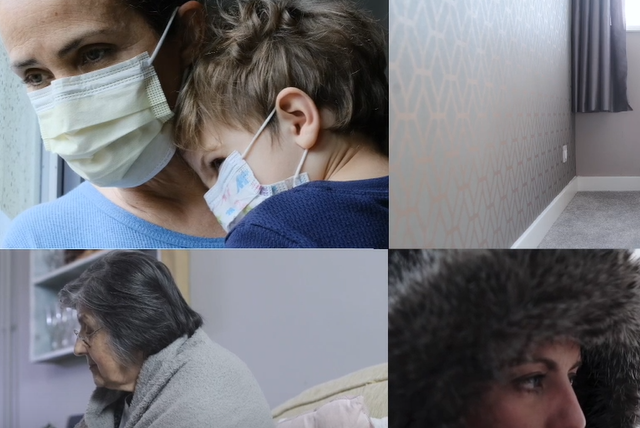Guidelines
The following guidelines outline the general approach to integrating behaviour change approaches while engaging energy poor within the EnergyMeasures project. The presented steps utlined which detail the steps to be taken in engaging with energy poor households and how behaviour change is integraed, including: registration and preliminary data collection; first household visit and gathering of information; data analysis and preparation of bespoke plans; second household visit, deployment of energy measures and agreement of behaviour change plan; and provision of ongoing support.
Registration
First visitation
Data analysis
Second visitation
Ongoing support
Step 1: Registration and initial gathering of data
Following confirmation that a household wishes to participate, householders should be invited to register with the project, and arrange their first visitation. This registration may be completed in a number of ways including: returning a physical paper form; via telephone call; via email or over the internet; in person at time of recruitment; etc. Participants should be asked to provide the following basic information:
- Contact name, telephone number and email address
- Confirmation that they meet the criteria for participation in the project
- Address of dwelling (including any specific access information)
- Number of persons living in the household
- Size of dwelling
- Number of rooms
- Sources of energy used in dwelling
Step 2: First household visitation/ contact
A cautious approach should be adopted in face–o–face interactions with households, especially during visits where people might be infected by Covid-19. In these cases, project energy advisors should adhere to public health advice and best practice. During household visitations there are four key steps to be undertaken, as detailed below.
Introduction
The project energy advisors should introduce themselves to householders on arrival and outline the details of the visitation. Details collected during registration should be confirmed (including eligibility).
Collection
Using the templates devised for the project (and through discussion with householders), energy consumption data (both electricity and heating energy) should be collected for the household.
Inspection
The project energy advisors should undertake a tour of the household to gather information about the physical and technical aspects of the dwelling, and to look at energy-using appliances, including measuring power consumption using energy monitoring adapters.
Discussion
Householders should then be engaged in a discussion (using the interview schedule developed for the project) covering their household practices, examining their use of particular appliances, discussing perceived energy-related problems, exploring potential solutions, etc.
Below is indicative information to be gathered regarding different aspects of the dwelling:
Heating System
Type and age of system? When was the boiler last serviced?
Bathing
Do they take a shower or a bath? How many per week and for how long? What are water flow rates?
Radiators
How many are there and what type are they? Are they air- blocked? do they have reflective foils at back? Is heat emission obstructedt?
Windows & Doors
Are windows double-glazed? Are there draughts? Do windows (hinges) need to be adjusted?
Lighting
What is the number of light bulbs? What type are they and what wattage do they have?
Chimney
Is there an open fire? How often the chimney being used? Can the flue be closed?
Fridges & Freezers
What are their temperature setting? What is the quality of the seals and where are they positioned? How often are they being defrosted?
Cooking
What types of appliances are used for cooking? What is the cooking routine? Is the kettle constantly being boiled?
Laundry
How many loads are washed a week and at what temperature? Whish program is being used?
General devices
What is the power consumption type (on/ standby/ plugged in)? How often are they being used per day? How much time are they on stand-by?
Hot water
Is there a hot water cylinder jacket? Is there any lagging on piping?
General Questions
Are there any issues with mould?
Step 3: Data analysis and evaluation
The insights on supplied by householders on their daily practices, the information collected on the dwelling and appliances within, and the quantitative data collected on energy consumption should be analysed and assessed in a systematic manner. In achieving this the energy advisor (with appropriate support from colleagues and partners) will:

- Compare the consumption data with that of similar households to highlight elevated levels of consumption and indicate those households where there is particular scope for energy savings;
- Compare the aggregate power consumption data for appliance with the total energy consumption to indicate so–called hidden energy use within the household i.e., consumption attributable to devices unaccounted for (e.g., second freezer) or incorrect estimates of usage time of known devices;
- Examine individual device–level consumption data to indicate saving potentials associated with them, and so determine the relative importance of behaviour associated with each;
- Review the consumption data and analyse the information supplied by the households to develop an understanding of their household practices and what they mean for their patterns of energy use;
- Use the developed knowledge to:
- Work with householders to, select a package of no–cost and low–cost energy conservation and efficiency measures which are most appropriate for the dwelling;
- Devise a tailored behaviour change plan for householders to implement in their daily lives, including a relevant mix of efficiency, curtailment, and maintenance behaviour

Step 4: Second household visitation
The second household visitation should take place following the analysis of the collected information, the identification of appropriate low–cost measures, and the preparation of household behaviour change plan. This should take place as soon as practical after the initial visitation to maintain the householders’ interest in and engagement in the initiative. During the second visitation, the project energy advisors will:

- Provide households with a brief report detailing the energy undertaken for the household
- Talk householders through the report highlighting key results and relating how they relate to the recommendations
- Discuss with the householders the no–cost and low–cost energy conservation and efficiency measures most appropriate for them, and agree a package of measure to be deployed
- Talk through, and as appropriate, assist the householders in deploying the energy measures
- Present the tailored household behaviour change plan, talk through the various proposed behaviours, and discuss its adoption with householders, Identifying barriers and where possible potential supports
- Provide energy saving information brochures relevant to both the deployed energy measures and suggested efficiency, curtailment, and maintenance energy behaviours
- Inform householders of EnergyMeasures supports available to optimise use of their energy measures, but particular to support their changes in energy–related behaviours
- Get householders to sign project participant sheet to (i) confirm completion of household visitation; (ii) acknowledge receipt of energy measures; (iii) agree to household behaviour change plans

Step 5: Follow-up support for householders

Ongoing support for behaviour change will be provided to households over the course of 2–3 further household contacts – these may take the form of in–person visits (where circumstances permit), but will emphasise telephone and video calls both for reasons of public health (as previously discussed) and as a means of increasing the efficiency of the process. Here the project energy advisor will talk with the householders through their experience of the low–costs measures and of implementing changes in their energy–related behaviours – collecting feedback from the participants, providing advice and guidance where possible, and redirecting for support if appropriate. Assistance will be also provided where needed in choosing appliances, reading energy bills, switching energy providers, and accessing grants.
In addition to these direct household contact there will be regular text alerts, email bulletins and social media updates to keep people engaged. The EnergyMeasures website also includes energy saving tips, household energy calculators and works to create a ‘behaviour change community’ by integrating social media and inviting participants to share energy saving tips, problems and advice. Participants will be encouraged to upload their energy–saving ideas and stories of their successes, and there will be a series of competitions with energy– efficient appliances as incentives.
Other articles

How complex is it to come up with a universal definition of energy poverty?
Considering the development of recent geopolitical situation the issue of energy poverty is increasingly pressing. There are many governmental and small initiative efforts to combat this problem, yet one element, which affects the effectiveness of those efforts, persists. Namely, what is energy poverty and can we establish a universal definition?

Sometimes, Energy Poverty is a Hidden Problem
The EnergyMeasures project uses a behavior change approach to mitigate energy vulnerability in seven European countries. At the halfway point of the project, the question arises: Is the chosen strategy working?

A Chain-Reaction of Negative Consequences of Living in Energy Poverty
A series of interviews conducted with citizens and stakeholder organisations shows how people experience energy poverty and also the institutional support offered to affected households in seven European countries.
vector images designed by vectorpouch / Freepik